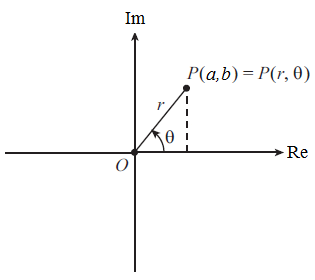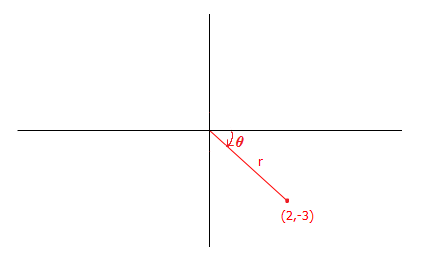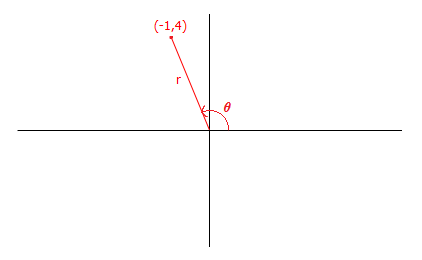Polar Form and De Moivre's Theorem
Definition
Polar Form
In addition to the Cartesian form, z=a+bi, complex numbers can also be written in trigonometric polar form z=r(cosθ+isinθ) where r is the modulus and θ is the argument of the number, in radians.
You may see cisθ used in calculations with complex numbers - this is a shorthand for cosθ+isinθ.

|center
See the page on Modulus and Argument for a full description of the calculation of r and θ.
Recall Euler's formula, which relates exponentials and trigonometric formulae.
eiθ=cosθ+isinθ
Using this, we can also write complex numbers in exponential polar form
z=reiθ
The angle notation is often used in electronics: z=r∠θ
De Moivre's Theorem
De Moivre's theorem states that for any complex number z=cosθ+isinθ and integer n, (cosθ+isinθ)n=cos(nθ)+isin(nθ) This can be stated in exponential polar form as (eiθ)n=einθ
De Moivre's theorem is useful when finding a power of a complex number. To apply the theorem to a complex number, first convert it to polar form, then apply the identity given in the theorem: (a+bi)n=(r(cosθ+isinθ))n=rn⋅(cosθ+isinθ)n=rn(cos(nθ)+isin(nθ))
Worked Examples
Example 1
Express the complex number z=2−3i in polar form.
Solution
Find the modulus and the argument.
r=|z|=√22+(−3)2=√13
θ=argz=tan−1(−32)=−0.98 radians (to 2 d.p.)
Note: Remember to check that the value for θ is correct by drawing an Argand diagram. See Modulus and Argument for more detail on finding the argument.

In exponential polar form, z=√13e−0.98i
Or, in trigonometic polar form, z=√13(cos(−0.98)+isin(−0.98))
Example 2
Use De Moivre's Theorem to compute (−1+4i)4.
Solution
First, find the modulus. |−1+4i|=√(−1)2+42=√17
Then find the argument. If we are not careful then we could calculate as follows: arg(−1+4i)=tan−1(4−1)=tan−1(−4)=−1.33

But the angle θ=−1.33 radians lies in the fourth quadrant and we see that it does not correspond with the point (−1,4), which lies in the second quadrant. We must add π to this to correct it. See Modulus and Argument for a full discussion and plenty of examples.
So the actual value for θ is: θ=π+tan−1(−4)=1.82 radians (to 2 d.p.)
Now we can write the complex number in polar form. (−1+4i)=√17(cos1.82+isin1.82)
So (−1+4i)4=(√17(cos1.82+isin1.82))4=(√17)4×(cos1.82+isin1.82))4=172×(cos(4×1.82)+isin(4×1.82)) (by De Moivre's theorem)=289(cos7.28+isin7.28) in polar form, or=156.9+242.7i (to 1 d.p.)
Workbooks
These workbooks produced by HELM are good revision aids, containing key points for revision and many worked examples.
See Also
External Resources
- The exponential form workbook at mathcentre.
- Trigonometric polar form workbook at mathcentre.
- The polar form of a complex number leaflet at mathcentre.